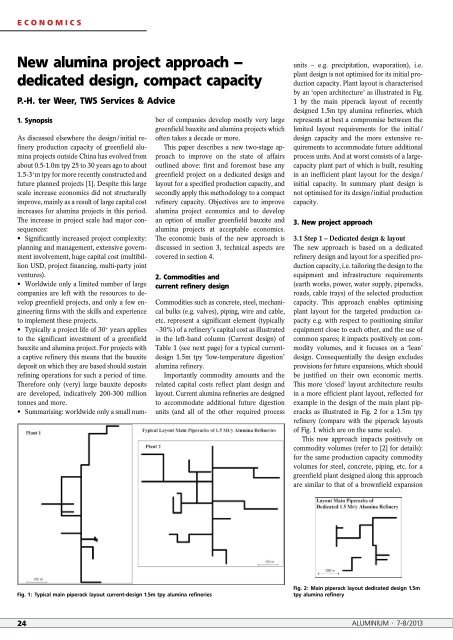special - Alu-web.de
special - Alu-web.de
special - Alu-web.de
You also want an ePaper? Increase the reach of your titles
YUMPU automatically turns print PDFs into web optimized ePapers that Google loves.
ECo N o M i CS<br />
New alumina project approach –<br />
<strong>de</strong>dicated <strong>de</strong>sign, compact capacity<br />
P.-h. ter Weer, tWS Services & Advice<br />
1. Synopsis<br />
As discussed elsewhere the <strong>de</strong>sign / initial refinery<br />
production capacity of greenfield alumina<br />
projects outsi<strong>de</strong> China has evolved from<br />
about 0.51.0m tpy 25 to 30 years ago to about<br />
1.53 + m tpy for more recently constructed and<br />
future planned projects [1]. Despite this large<br />
scale increase economics did not structurally<br />
improve, mainly as a result of large capital cost<br />
increases for alumina projects in this period.<br />
The increase in project scale had major consequences:<br />
• Significantly increased project complexity:<br />
planning and management, extensive government<br />
involvement, huge capital cost (multibillion<br />
USD, project financing, multiparty joint<br />
ventures).<br />
• Worldwi<strong>de</strong> only a limited number of large<br />
companies are left with the resources to <strong>de</strong>velop<br />
greenfield projects, and only a few engineering<br />
firms with the skills and experience<br />
to implement these projects.<br />
• Typically a project life of 30 + years applies<br />
to the significant investment of a greenfield<br />
bauxite and alumina project. For projects with<br />
a captive refinery this means that the bauxite<br />
<strong>de</strong>posit on which they are based should sustain<br />
refining operations for such a period of time.<br />
Therefore only (very) large bauxite <strong>de</strong>posits<br />
are <strong>de</strong>veloped, indicatively 200300 million<br />
tonnes and more.<br />
• Summarising: worldwi<strong>de</strong> only a small num<br />
ber of companies <strong>de</strong>velop mostly very large<br />
greenfield bauxite and alumina projects which<br />
often takes a <strong>de</strong>ca<strong>de</strong> or more.<br />
This paper <strong>de</strong>scribes a new twostage approach<br />
to improve on the state of affairs<br />
outlined above: first and foremost base any<br />
greenfield project on a <strong>de</strong>dicated <strong>de</strong>sign and<br />
layout for a specified production capacity, and<br />
secondly apply this methodology to a compact<br />
refinery capacity. Objectives are to improve<br />
alumina project economics and to <strong>de</strong>velop<br />
an option of smaller greenfield bauxite and<br />
alumina projects at acceptable economics.<br />
The economic basis of the new approach is<br />
discussed in section 3, technical aspects are<br />
covered in section 4.<br />
2. Commodities and<br />
current refinery <strong>de</strong>sign<br />
Commodities such as concrete, steel, mechanical<br />
bulks (e.g. valves), piping, wire and cable,<br />
etc. represent a significant element (typically<br />
~30%) of a refinery’s capital cost as illustrated<br />
in the lefthand column (Current <strong>de</strong>sign) of<br />
Table 1 (see next page) for a typical current<strong>de</strong>sign<br />
1.5m tpy ‘lowtemperature digestion’<br />
alumina refinery.<br />
Importantly commodity amounts and the<br />
related capital costs reflect plant <strong>de</strong>sign and<br />
layout. Current alumina refineries are <strong>de</strong>signed<br />
to accommodate additional future digestion<br />
units (and all of the other required process<br />
units – e.g. precipitation, evaporation), i.e.<br />
plant <strong>de</strong>sign is not optimised for its initial production<br />
capacity. Plant layout is characterised<br />
by an ‘open architecture’ as illustrated in Fig.<br />
1 by the main piperack layout of recently<br />
<strong>de</strong>signed 1.5m tpy alumina refineries, which<br />
represents at best a compromise between the<br />
limited layout requirements for the initial /<br />
<strong>de</strong>sign capacity and the more extensive requirements<br />
to accommodate future additional<br />
process units. And at worst consists of a largecapacity<br />
plant part of which is built, resulting<br />
in an inefficient plant layout for the <strong>de</strong>sign /<br />
initial capacity. In summary plant <strong>de</strong>sign is<br />
not optimised for its <strong>de</strong>sign / initial production<br />
capacity.<br />
3. New project approach<br />
3.1 Step 1 – Dedicated <strong>de</strong>sign & layout<br />
The new approach is based on a <strong>de</strong>dicated<br />
refinery <strong>de</strong>sign and layout for a specified production<br />
capacity, i.e. tailoring the <strong>de</strong>sign to the<br />
equipment and infrastructure requirements<br />
(earth works, power, water supply, piperacks,<br />
roads, cable trays) of the selected production<br />
capacity. This approach enables optimising<br />
plant layout for the targeted production capacity<br />
e.g. with respect to positioning similar<br />
equipment close to each other, and the use of<br />
common spares; it impacts positively on commodity<br />
volumes, and it focuses on a ‘lean’<br />
<strong>de</strong>sign. Consequentially the <strong>de</strong>sign exclu<strong>de</strong>s<br />
provisions for future expansions, which should<br />
be justified on their own economic merits.<br />
This more ‘closed’ layout architecture results<br />
in a more efficient plant layout, reflected for<br />
example in the <strong>de</strong>sign of the main plant piperacks<br />
as illustrated in Fig. 2 for a 1.5m tpy<br />
refinery (compare with the piperack layouts<br />
of Fig. 1 which are on the same scale).<br />
This new approach impacts positively on<br />
commodity volumes (refer to [2] for <strong>de</strong>tails):<br />
for the same production capacity commodity<br />
volumes for steel, concrete, piping, etc. for a<br />
greenfield plant <strong>de</strong>signed along this approach<br />
are similar to that of a brownfield expansion<br />
Fig. 1: Typical main piperack layout current-<strong>de</strong>sign 1.5m tpy alumina refineries<br />
Fig. 2: Main piperack layout <strong>de</strong>dicated <strong>de</strong>sign 1.5m<br />
tpy alumina refinery<br />
24 ALUMINIUM · 7-8/2013
















